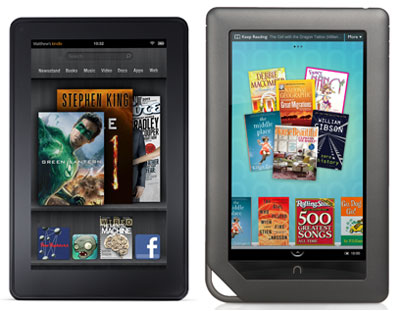 NEWS
NEWS
 NEWS
NEWS
 NEWS
NEWS
![]() In the last 18 months many businesses have seen iPads come in the door under the arms of their executives. Now they should prepare for the post-holiday appearance of potentially larger numbers of low-end tablets from the likes of Amazon and Barnes and Noble. The question is, what, if any, services will IT want to deliver both to employees and to customers with these low-end but highly functional tablets.
In the last 18 months many businesses have seen iPads come in the door under the arms of their executives. Now they should prepare for the post-holiday appearance of potentially larger numbers of low-end tablets from the likes of Amazon and Barnes and Noble. The question is, what, if any, services will IT want to deliver both to employees and to customers with these low-end but highly functional tablets.
The iPad is now officially a high-end table. It has been largely untouched by market competitors. But this holiday season will herald the real emergence of a low-end market for tablet devices from three players: Amazon.com, Barnes & Noble, and Kobo. These companies are redefining the low-end tablet market with full-function color Android devices priced from $200-$250.
By comparison, the other Android tablets are priced $100 to $200 higher, putting them in a difficult position. To maintain those prices, either they have to try to compete against the elegant and dominant Apple iPad for the high end of the market, a tough strategy to pull off given Apple’s prestige and mind-share, or they have to demonstrate compelling differentiation over the three low-end tablets in the price-sensitive low-end.
And that second choice will be difficult for them to execute given that all three publishers are aggressively partnering with third-party developers to bring exclusive apps to their platforms and with magazine publishers to increase their e-magazine stables.
So what should IT do about these low-end tablets when they show up in the office? Basically you have three choices:
Obviously the first choice is the easiest. So why is that not the best? Opportunity. These tablets are priced at less than half the cost of a new iPad, quantity one. On the other hand, they do not provide nearly the level of functionality of the iPad or the new HP Slate. And these have to be seen as low-security devices, not something that you want your corporate data residing on.
But they are designed mainly as front-end devices for consuming media from the cloud, and that media can be business-oriented. If your company uses SaaS services such as Salesforce.com or provides private cloud services that deliver information to browsers, these could be excellent, low-cost tools for consuming those services at a cost far below alternative devices. And they are designed as book/magazine readers, which means they can also be used to read PDF business reports and presentation slide decks. And two are standard Android systems that should be able to run any Android front end offered, for instance, by cloud services.
Actually a case could be made for picking one as a company standard and equipping your outside sales, support, and other personnel who spend large amounts of their day away from their desks. Given their low cost, they could easily save back their cost just in savings by eliminating paper/printing costs of everything from presentations to maintenance manuals and bulletins. And cutting paper in the office is a good way to improve the corporate green footprint as well. And tablets have obvious huge potential as sales devices, both for retail and outside sales.
Of course all this is true of iPads, the new HP Slate, and more expensive Android tablets. But given their price and the marketing the three publishers are putting behind them, many companies may find more of these coming into their offices in January than iPads. And if you are considering equipping employees with a company standard tablet and these fit your company’s mobility needs, then why pay more?
THANK YOU